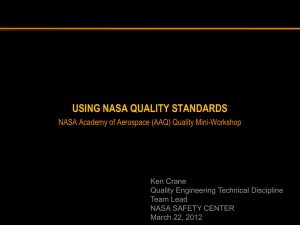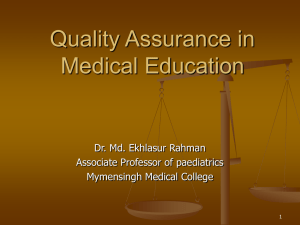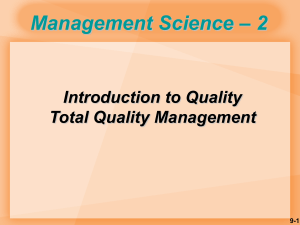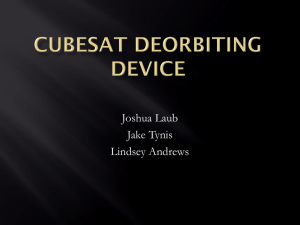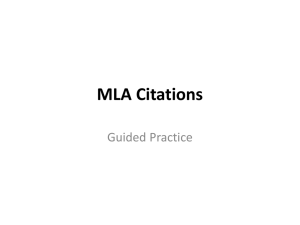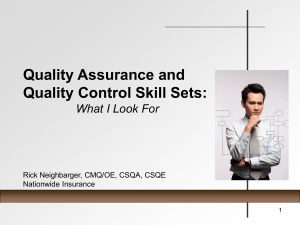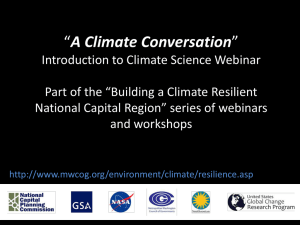Payload Quality Assurance - Academy of Aerospace Quality
advertisement
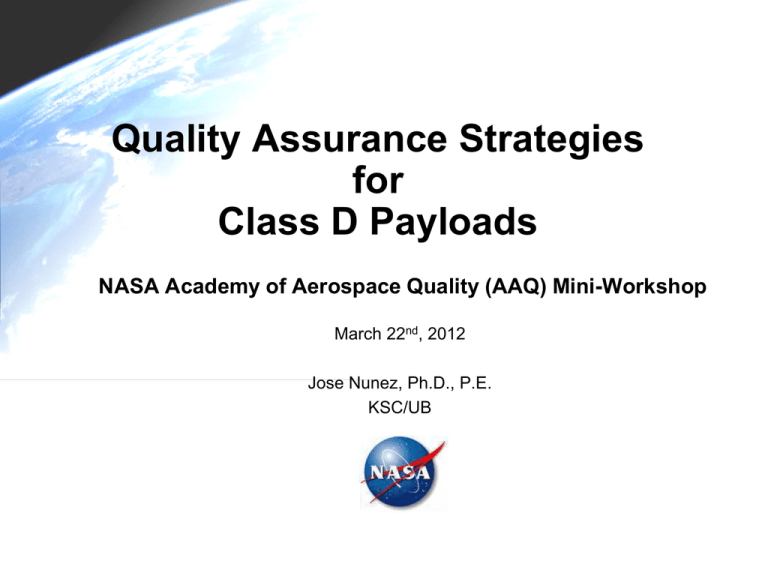
Quality Assurance Strategies for Class D Payloads NASA Academy of Aerospace Quality (AAQ) Mini-Workshop March 22nd, 2012 Jose Nunez, Ph.D., P.E. KSC/UB "What I lack in Quality Assurance requirements, I more than make up for in my uncanny ability to know my limitations." Cartoon by P.C. Vey Page No. 2 “Strategists point out that the highest returns come when a company focuses on a single strategy, commits fully to it, and aligns all resources accordingly. When you look back at companies that have been successful, they often appear to have used this strategy.” – Harvard Business Review, June 2008 Page No. 3 However, investing in the big opportunity brings along a chance for the big catastrophe. As Michael Raynor argues in The Strategy Paradox, “the real world in general, and competitive markets in particular, are filled with great unknowns, the same focus and commitment that promise the highest return also carry the greatest risk of failure.” Raynor further suggests that CEOs “should focus not only in achieving results but managing uncertainty.” Page No. 4 A century ago, Andrew Carnegie had this advice: “Concentrate your energies, your thoughts, and your capital. The wise man puts all his eggs in one basket and watches the basket.” But of course the risk, now and then, is that no matter how attentive and focused we are, the basket we’re watching could end up being the wrong one… Page No. 5 "The key difference with the new Strategy is that what we once feared most, is now our best-case scenario." Cartoon & Caption by P.C. Vey Page No. 6 Topics • Quality Requirements - The Quality Policy Document Tree • NASA Class A-D Payloads – Risk Classifications for NASA Payloads, NPR 8705.4 • Reflective Questions • High School CubeSat initiative • NASA General Safety Program Requirements, NPR 8715.3C • Quality Assurance Plans, NPR 8735.2 • Concluding Thoughts Page No. 7 The Quality Policy Document Tree Risk Classifications NPR 8705.4 Credit: NASA Safety Center’s SMA Technical Excellence Program (STEP) Page No. 8 Classification Considerations for NASA Class A-D Payloads, NPR 8705.4 Characterization Class A Class B Priority (Criticality to High priority, very low High priority, low risk Agency Strategic Plan) and (minimized) risk Acceptable Risk Level Class D Medium priority, medium risk Low priority, high risk National significance Very high High Medium Low to medium Complexity Very high to high High to medium Medium to low Medium to low Mission Lifetime (Primary Baseline Mission Cost Launch Constraints Long, >5years Medium, 2-5 years Short, <2 years Short < 2 years High Critical High to medium Medium Medium to low Few Low Few to none In-Flight Maintenance N/A Not feasible or difficult Maybe feasible Alternative Research Opportunities or Re-flight Opportunities Achievement of Mission Success Criteria No alternative or reflight opportunities Few or no alternative or re-flight opportunities Stringent assurance standards with only minor compromises in application to maintain a low risk to mission success. Examples Page No. 9 Class C May be feasible and planned Some or few Significant alternative or alternative or re-flight re-flight opportunities opportunities Medium risk of not Medium or significant achieving mission risk of not achieving success may be mission success is acceptable. Reduced permitted. Minimal assurance standards assurance standards are permitted. are permitted. All practical measures are taken to achieve minimum risk to mission success. The highest assurance standards are used. HST, Cassini, JIMO, MER, MRO, Discovery ESSP, Explorer SPARTAN, GAS Can, JWST payloads, ISS Facility Payloads, MIDEX, technology Class Payloads, ISS complex subrack demonstrators, simple Attached ISS payloads payloads ISS, express middeck and subrack payloads, SMEX KSC Mentoring High School on CubeSat Mission Initiative Primary mission objectives • Measure launch vehicle shock and vibration environments during ascent to better quantify flight environments • Have an image on the aft face of the cube that can be captured by the 2U CubeSat (once jettisoned) • Demonstrate RF transmission of a CubeSat within a P-POD with less than 1 Watt during launch vehicle ascent. • To be originated & developed by Merritt Island High School (Mascot: Mustangs, thus Stang-Sat) Page No. 10 Merritt Island High School CubeSat P-POD Measure Vibration & Acceleration 11 Page No. 11 Personal Observations • Found myself questioning every requirement – Determining whether they were value-added or just documentation based – Mindset of “the less requirements the better” • Momentarily forgot the benefits of developing a thought out plan would be for the high school students – A plan that would include key elements of Project Mgmt, Safety & Quality Assurance along that of Testing and Validation. Page No. 12 Reflective Questions 1. Since Quality Assurance requirements are not as stringent for Class D payloads, should Universities self impose them? 2. As a stakeholder University, wouldn’t you want to hold the Project Manager accountable to some of the same standards, particularly as they apply to Safety & Quality Assurance? 3. Should I invest in a Quality Assurance Plan? Page No. 13 So, Strategically Speaking • If am risk-averse, which additional requirements should I (as an University) look into having my Project Manager and Team be responsible for? Page No. 14 The Quality Policy Document Tree Risk Classifications NPR 8705.4 Credit: NASA Safety Center’s SMA Technical Excellence Program (STEP) Page No. 15 General Safety Requirements NPR 8715.3C Roles and Responsibilities for NASA Safety Requirements, NPR 8715.3C Responsible Entity NPR 8715.3C Paragraph Project Managers 1.3.1, 1.3.2, 1.5.2, 1.6.1.1, 1.6.2.1, 1.7.1.1, 1.7.2.1, 1.7.3.1, 1.7.4, 1.13.4, 1.14.3, 2.2.1, 2.5.1.1, 2.5.3.1, 2.5.4.1, 3.5.1, 3.8.2, 3.9.2, 3.9.3.1, 3.9.4.1, 3.10.1, 3.11.1, 3.11.2, 3.12.2, 3.13.4.2, 3.13.4.3, 3.13.4.4, 3.14.2, 3.14.3.2, 3.14.4.1, 3.14.5.1, 3.14.6.1, 3.14.7.2, 3.15.3, 3.15.4, 3.15.7.1, 3.15.8.1, 3.15.9.1, 3.17.4, 4.2.1, 7.2.1, 7.4.1, 7.4.6.3, 7.5.3, 7.6.1, 9.2.1, 9.2.2, 9.3.1, 9.5.1, 9.5.2, 9.6.1, 9.7.1, 10.2.5, 10.3, 11.3.5 Page No. 16 Quality Assurance Plan • Key item: – Research examples and/or methods (as those listed in NPR 8735.2) for incorporating a Quality Assurance Plan (similar to a Project Plan) for your Payload o Specifically, ways to document problems along with corrective actions Page No. 17 Access to NASA Procedural Requirements and Policies • NASA Online Directive Information System or NODIS – http://nodis3.gsfc.nasa.gov/ Page No. 18 Conclusion • As Class D Payloads, think about if adding additional rigor to your Payload team is worth the invesment Page No. 19 Concluding Thoughts "Everyone offers to carry her books? What you need is a better Quality Assurance proposition." Cartoon by C. Covert Darbyshire Page No. 20

